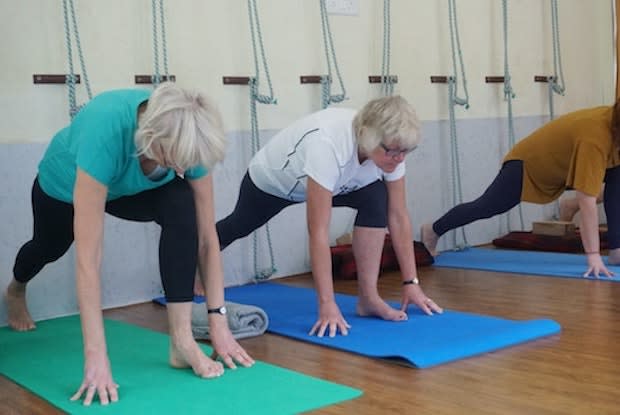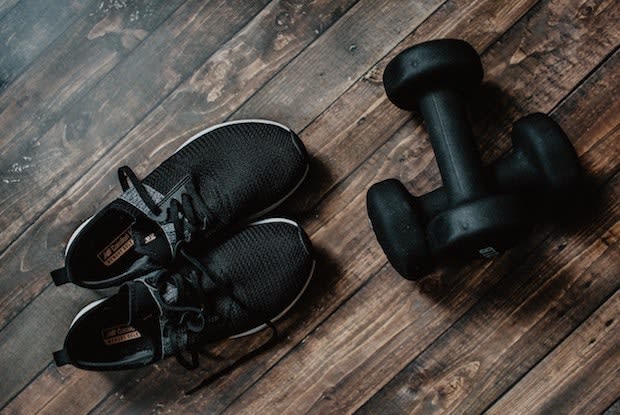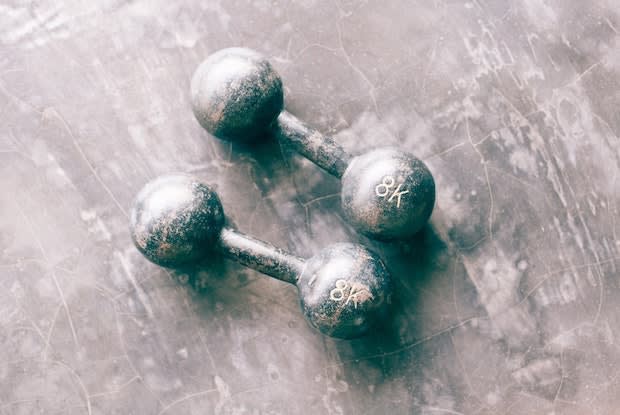Table of Contents
III. Muscle-Strengthening Exercises
Understanding Porous Bones
Many people with osteoporosis may be nervous about jumping into an exercise routine. This is understandable because osteoporosis can result in low bone density and can lead to fractures. Osteoporosis is most common in postmenopausal women, but it can occur in both men and women. Women are more at risk because of the drop in estrogen that occurs when women enter menopause. Women also have smaller, thinner, and less dense bones than men. [1]
This condition affects over 10 million Americans, so you must have regular checkups with your doctor if you are at risk. Unfortunately, most women do not even know they have osteoporosis until they break a bone. If you undergo a bone density test and your doctor thinks you are at risk, they may prescribe you medications like Boniva (ibandronate), Fosamax (alendronate), or Evista (raloxifene). [1]
If you are diagnosed with osteoporosis, you do not have to stop all physical activity. With a doctor’s supervision and guidance, you can still live a full and active life. Read on to learn more about exercises you can do while living with osteoporosis. [1]
If you are an older adult, it may be difficult to come to terms with the fact that you may not be able to do the same sports or hobbies you did in the past. This is normal, and it does not mean that there are no other activities you may come to enjoy in this phase of life. There are several stages of osteoporosis, and your doctor will let you know your stage as well as your fitness level. Your exercise routine should be based around the following: The older you are, the more likely you have other accompanying health problems. Your doctor may also tailor your exercise plan based on pre-existing conditions like obesity, high blood pressure, and heart disease. [2] Any exercise that moves your body and acts as a resistance against gravity is qualified as a muscle-strengthening exercise. You do not have to lift heavy weights to build up your muscles. Several workouts can slow bone loss and prevent fall-related fractures. Workouts can include very basic movements like standing and rising on your toes and lifting your body weight with exercises like push-ups, tricep dips, and squats. If you want to use the equipment, you can also purchase: Exercises that do not put a strain on the bones are recommended for moderate to severe osteoporosis patients. Low-impact activities do not strengthen the bones, but they can have beneficial effects on your flexibility and balance. If you have improved balance and flexibility, you are less likely to experience falls and bone fractures. Tai chi is a balance exercise that can improve these two things. It is important to know your limits with tai chi because certain forward-bending exercises may increase fracture risk. [3] Yoga and pilates are two other activities that have a low-impact on the body. These two exercises have several skill levels, so it is important to start slowly and gradually. You will likely get better and better as time goes on. You can practice poses that strengthen the back, including baby cobra, sphinx, and bridge. Other poses like mountain and chair pose can improve leg strength. If you attend a yoga or pilates class, tell your instructor that you have osteoporosis, so they are aware of your limitations. [4] You can still participate in high-impact weight-bearing exercises with osteoporosis if your doctor says that your bones are strong enough. These activities can help build bones and keep them strong. If you have a broken bone or are recovering from a fracture, you should avoid high-intensity exercises. Some weight-bearing exercises can include: Living with osteoporosis does not mean you have to wrap yourself in bubble wrap and stay indoors for the rest of your life. Once your doctor lets you know what exercises you can safely perform, you can get your body moving. As mentioned earlier, yoga and pilates are safe exercises, but there are plenty more you can perform at home without an instructor's help. Read on for some examples. Bicep Curls: You don’t need to pump iron to do successful bicep curls. Bicep curls can be performed with dumbbells weighing one to five pounds. You can also use a resistance band. You can do bicep curls seated or standing. Take the dumbbells in each hand and pull the weights toward your chest. Lower the weights and repeat this exercise for three sets of 12 repetitions. [5] Foot Stomps: Foot stomps may sound silly, but they can make the hip bones stronger and less likely to fracture. When standing, imagine you are crushing an imaginary bug and stomp your foot. Repeat this exercise a few times on each foot. If you do not have good balance, hold onto a sturdy piece of furniture while performing foot stomps. Hamstring Curls: These curls strengthen the muscles in the backs of your legs. To perform this exercise, stand shoulder-width apart and move your heel back towards your buttocks as if you are lightly kicking yourself in the buttocks. Repeat this exercise on both sides. Squats: This type of exercise can strengthen the front of the legs and buttocks. To squat, stand with your feet hip-width apart and rest your hands on something stable to keep your balance. Bend the knees and squat down as if you are trying to sit in an invisible chair. You know you’ve completed the squat when the thighs are parallel to the ground. Rise back to standing and repeat. [5] The content provided in this article is based on thorough research and in some cases, reviewed by a medical professional. Our goal for the information is to provide helpful, general health informational. It is not intended as a substitute for professional medical advice.
Doctor’s Orders
Muscle-Strengthening Exercises

Low-Impact Exercises
High-Impact Exercises
Exercise Examples

